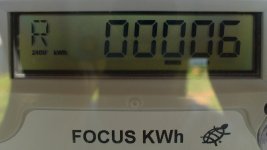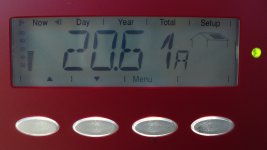Costs:
Cells, rails, hardware: 31,700
10 KW inverter: 5900
Wire, conduit, panels: 565
Shed: 1000 (need to go through invoices and get that nailed down better, lots of Lowes trips....
Concrete & labor: 450 (I hired a local group to help with labor- a good idea)
Total: $ 39,615
After Fed and State tax credits, it should be about $20K. I'm not including my labor.
I have a contract to buy $1669 worth of power each year, which in the narrowest sense of "payback" means 12 years. The system has a 20 year life, where that means it outputs 90% of it's original capacity.
Most discussions of payback have subtle biases built in. I'll bet very few tractor owners can come up with a payback time for their equipment. So payback times tend to be things people manipulate to justify what they wanted in the first place. Seems unlikely I'm that objective and an exception to the rule.
Things that modify the payback time are:
Future cost of electricity and if a time of use billing goes into effect.
Cost of lost opportunity of money (think "If I had left that money in a money market or bond fund, would I be better off in 20 years?")
Is your labor really free? Cost of lost opportunity for my time.
So if power cost don't increase, and interest rates or bond rates go back up into the 5-7 percent range, I should have kept my money. If this area went to a 30 cents per KWH time of day use (like some parts of California) and the interest rates and bond rates stay below 2.5%, I look like a genius with a 6 year payback and making about $2700 per year or so.
If you look at this from a strictly economic point of view, you can't justify it. But by the same stringent rules, I couldn't justify my tractors (vs. hiring the big jobs out). At this point in the solar game, people playing have justifications beyond the simple economics.
As for the tracking system and panel angle, this fixed array is certainly the simplest thing to do in terms of moving cost and semi-anual maintenance. It is probably representative of what you would see in a residential environment. Which leads me to part of the why:
I was ready to launch a home automation product in 2009 that is best for new residential construction in the 3000 to 6000 sq foot home size. Yeah, I can call them all right :laughing:. But there are lots of people spending $10K to $100K on solar panels. With no new software or sensors, I can monitor all that stuff so they can look at their energy use and generation from the house or office. And then after that there's a "Oh yeah, it also does home automation too" moment. So this will let me learn all about this sort of thing and help me start up a new business.
In my county in NC alone there are 46 small PV installations, and over 330 in the state. Another part of "why" is because it is an interesting project and I enjoyed doing it. Being an early adopter is usually tricky and expensive. I know people who paid $5K in 1985 (or about $15K in todays dollars) to by a IBM PC with a _full_ 620K (or so) so they could type letters and write programs. I spent $2K in 1983 for an 8 Mbyte hard drive for my home computer I built. I spent $2.5K in 1971 for a used PDP-8 computer. All that paid of handsomely as time marched on. If I had waited for computers to become economically viable, the catch up game on the technology would have been too much.
I mentioned at the start of this post about biases, I want mine to be clear and fully admit that on economics alone, solar PV is not there.
I'm going to do about 3 posts next with a thought on solar PV power. A heads up to the monitors of the site, if it's too off topic or deemed political nuke it and there will be no hard feelings. I think there are some interesting aspects to solar PV down the road that are worth thinking about. Lets NOT have a thread about global warming, energy tax subsides, and the like. Those have been beaten to death already. I'm just trying to explain what I did, give some of my thoughts as to why I did it, and then get people to think about what (if any) role solar PV might have for the U.S.
Pete





